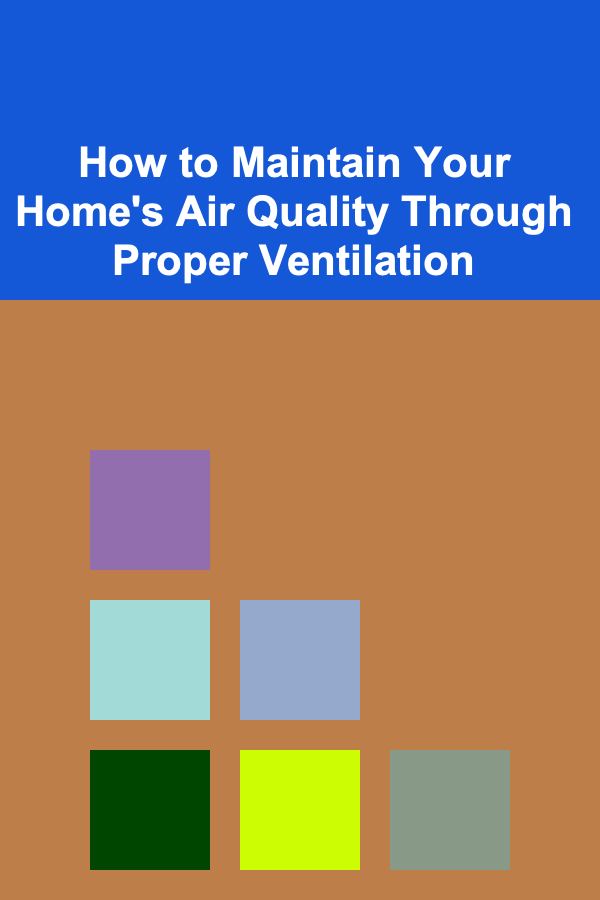
How to Maintain Your Home's Air Quality Through Proper Ventilation
ebook include PDF & Audio bundle (Micro Guide)
$12.99$10.99
Limited Time Offer! Order within the next:

Indoor air quality (IAQ) is a critical component of a healthy living environment, and the ventilation system plays a pivotal role in maintaining it. Proper ventilation ensures that your home has a steady flow of fresh air, reduces indoor pollutants, and keeps humidity levels in check. It also helps in the removal of indoor contaminants such as dust, allergens, volatile organic compounds (VOCs), and carbon dioxide (CO2). Poor ventilation can lead to a range of health issues, from respiratory problems to chronic fatigue, and it can worsen conditions like asthma and allergies.
In this article, we will explore the importance of air quality, the role of ventilation in improving it, and practical strategies to maintain and optimize your home's air quality through proper ventilation.
The Importance of Indoor Air Quality
Indoor air quality refers to the condition of the air inside buildings and structures. It affects the health and well-being of the occupants. Poor air quality can lead to a variety of health problems, including:
- Respiratory Issues: Exposure to pollutants like dust, smoke, and mold can lead to respiratory diseases such as asthma, bronchitis, and chronic obstructive pulmonary disease (COPD).
- Allergies: Dust mites, pet dander, and pollen can trigger allergic reactions in sensitive individuals, leading to symptoms like sneezing, coughing, and itchy eyes.
- Toxic Exposure: Volatile organic compounds (VOCs) found in paints, cleaning products, and furniture can contribute to headaches, dizziness, and more severe long-term health issues.
- Fatigue and Decreased Productivity: High CO2 levels from poor ventilation can lead to fatigue, reduced cognitive function, and decreased productivity.
Common Indoor Pollutants
- Dust and Particles: Dust, dirt, and other particulate matter can accumulate inside homes, especially in high-traffic areas. These particles can irritate the respiratory system and trigger allergic reactions.
- Mold and Mildew: Moist environments promote the growth of mold and mildew, which can exacerbate respiratory issues and cause odors in the home.
- Carbon Dioxide (CO2): High concentrations of CO2, typically caused by inadequate ventilation in tightly sealed homes, can cause discomfort, dizziness, and drowsiness.
- Volatile Organic Compounds (VOCs): These are chemicals emitted from household products such as paints, cleaners, carpets, and furniture. Some VOCs are linked to long-term health problems.
- Carbon Monoxide (CO): This odorless and colorless gas can be lethal in high concentrations. It is commonly produced by gas stoves, fireplaces, and furnaces.
Inadequate ventilation can trap these pollutants inside, reducing the quality of indoor air and contributing to various health risks. By improving ventilation, you can minimize the concentration of these harmful substances and maintain a healthier indoor environment.
The Role of Ventilation in Air Quality
Ventilation is the process of exchanging indoor air with fresh outdoor air to improve indoor air quality. It helps to control humidity, remove excess heat, and eliminate indoor pollutants. Proper ventilation can be achieved through natural or mechanical means, depending on your home's design, location, and needs.
Types of Ventilation Systems
-
Natural Ventilation: This type of ventilation relies on natural forces such as wind, temperature differences, and the buoyancy of warm air to move air through a building. It can be achieved through windows, doors, vents, and skylights.
-
Advantages:
- Energy-efficient: It doesn't require mechanical equipment or electricity.
- Cost-effective: It relies on natural airflow, so it's free to use.
-
Challenges:
- Unpredictable: The effectiveness of natural ventilation depends on the weather and outdoor conditions.
- Limited control: It's hard to regulate the amount of fresh air entering the home, especially in very cold or hot climates.
-
-
Mechanical Ventilation: Mechanical ventilation uses fans and other mechanical systems to regulate airflow within a home. It can be further divided into three main categories:
-
Exhaust Ventilation: This system uses exhaust fans to remove stale indoor air from specific rooms, such as bathrooms, kitchens, or utility rooms, while allowing fresh air to enter through vents or windows.
-
Supply Ventilation: Supply ventilation systems introduce fresh outdoor air into the home, typically through a duct system. These systems are equipped with filters to remove outdoor pollutants before they enter the house.
-
Balanced Ventilation: A balanced ventilation system uses both exhaust and supply fans to ensure a constant exchange of indoor and outdoor air. Heat recovery ventilators (HRVs) and energy recovery ventilators (ERVs) are examples of systems that balance incoming and outgoing air.
-
Advantages:
- Consistent air quality: Mechanical ventilation ensures a constant supply of fresh air, even when natural ventilation is insufficient.
- Better control: These systems allow you to control the airflow and adjust the ventilation as needed.
-
Challenges:
- Higher upfront costs: Installing a mechanical ventilation system can be expensive.
- Ongoing maintenance: Mechanical systems require regular maintenance to ensure they function properly.
-
Strategies for Proper Ventilation
Maintaining proper ventilation requires a combination of good practices, proper equipment, and regular maintenance. Here are some strategies to help you maintain optimal indoor air quality.
1. Use Exhaust Fans in High-Humidity Areas
Bathrooms, kitchens, and laundry rooms are prone to high humidity levels, which can lead to mold and mildew growth. Installing and using exhaust fans in these areas can help eliminate moisture and prevent mold problems. Make sure to turn on the exhaust fan during and after activities that generate moisture, such as showering or cooking.
2. Keep Windows Open When Possible
If weather permits, open windows and doors to allow fresh air to circulate through the house. Even if you live in a noisy area, you can open windows on the opposite side of your home to allow cross-ventilation. This simple step can help improve air circulation and prevent the buildup of indoor pollutants.
3. Install a Whole-House Ventilation System
For homes that are tightly sealed or located in areas with high outdoor pollution, installing a whole-house ventilation system is a good solution. A balanced ventilation system or an energy recovery ventilator (ERV) can help bring in fresh air while exhausting stale air. These systems are particularly beneficial in homes that are well-insulated and have limited natural airflow.
4. Use Air Purifiers
In addition to ventilation, air purifiers can help reduce indoor air pollutants, particularly allergens and VOCs. Look for air purifiers with HEPA filters to capture fine particles and activated carbon filters to absorb gases. Place air purifiers in rooms where air quality is most concerning, such as bedrooms, living rooms, or kitchens.
5. Optimize Airflow with Ceiling Fans
Ceiling fans can help improve airflow and circulate air throughout the house. In the winter, set fans to rotate clockwise at a low speed to circulate warm air that rises to the ceiling. In the summer, set the fan to rotate counterclockwise to create a cooling breeze. Using ceiling fans in conjunction with your ventilation system can help maintain consistent air movement and prevent stagnation.
6. Maintain Your HVAC System
If your home has a central heating and cooling system, regular maintenance is crucial for optimal ventilation and air quality. Replace air filters every three months to ensure that the system is effectively trapping dust, allergens, and other particles. Also, schedule an annual inspection of your HVAC system to ensure that it is functioning properly and that the ducts are clean.
7. Seal Leaks and Gaps
Air leaks around windows, doors, and walls can lead to drafts and poor ventilation. Seal these leaks with weatherstripping, caulk, or foam insulation to prevent cold air from entering during the winter and hot air from entering during the summer. Sealing leaks also helps your ventilation system work more efficiently by reducing the strain on heating and cooling units.
8. Use Green Building Materials
If you're in the process of renovating your home or building a new one, choose materials that contribute to better indoor air quality. Many paints, adhesives, and building materials release VOCs that can pollute the air. Look for low-VOC or VOC-free alternatives when selecting paints, finishes, and flooring materials.
9. Monitor CO2 Levels
If you're concerned about CO2 buildup, consider installing a CO2 monitor to track air quality. High CO2 levels can cause fatigue, dizziness, and reduced cognitive function. If CO2 levels become elevated, increase ventilation by opening windows or adjusting your mechanical ventilation system to bring in fresh air.
10. Regularly Clean and Replace Filters
Whether it's your HVAC system, air purifiers, or exhaust fans, regularly cleaning and replacing filters is essential to maintaining good air quality. Dust and debris can accumulate in filters, reducing their effectiveness. Make it a habit to inspect and replace filters according to the manufacturer's recommendations to ensure optimal performance.
Conclusion
Maintaining optimal indoor air quality through proper ventilation is essential for a healthy living environment. Whether you rely on natural ventilation, mechanical systems, or a combination of both, ensuring a steady flow of fresh air will help remove pollutants, regulate humidity, and maintain comfort in your home. By implementing strategies like using exhaust fans, keeping windows open, and investing in whole-house ventilation systems, you can significantly improve the air quality in your home and reduce the risks associated with poor ventilation. Regular maintenance, monitoring air quality, and using air purifiers can further enhance the indoor environment, leading to a healthier and more comfortable living space for you and your family.
Reading More From Our Other Websites
- [Home Family Activity 101] How to Build a Family Reading Time Tradition
- [Whitewater Rafting Tip 101] Beyond the River: How to Build a Sustainable Income as a Certified Rafting Guide
- [Home Security 101] How to Install and Use Burglar Alarms for Houses: Expert Recommendations
- [Home Security 101] How to Install a DIY Security Camera System on a Budget
- [Home Pet Care 101] How to Prevent and Treat Common Flea Infestations in Pets
- [Organization Tip 101] How to Create a Sustainable Pantry with Eco-Friendly Products
- [Needle Felting Tip 101] DIY Gift Guide: Hand-Made Needle-Felted Pets That Impress Every Recipient
- [Rock Climbing Tip 101] How to Choose the Perfect Guidebook for Your Next Trip: A Step-by-Step Checklist
- [Organization Tip 101] Common Home Maintenance Tasks You Might Be Overlooking
- [Home Party Planning 101] How to Host a Virtual Party That's Just as Fun as the Real Thing

Creative DIY Home Organization Ideas to Maximize Your Space
Read More
How to Keep Your Pet's Toys Clean and Safe
Read More
How To Negotiate Business Deals Internationally
Read More
How to Set Realistic Financial Goals Based on Your Income
Read More
The Social Media Manager's Playbook: Tactics for Engaging Audiences and Driving Growth
Read More
How To Research Emerging Trends in the Crypto Space
Read MoreOther Products

Creative DIY Home Organization Ideas to Maximize Your Space
Read More
How to Keep Your Pet's Toys Clean and Safe
Read More
How To Negotiate Business Deals Internationally
Read More
How to Set Realistic Financial Goals Based on Your Income
Read More
The Social Media Manager's Playbook: Tactics for Engaging Audiences and Driving Growth
Read More